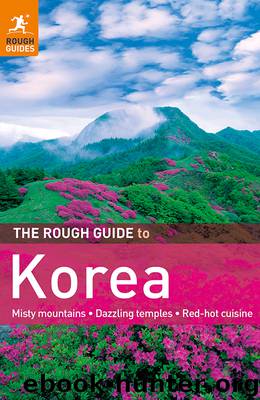The Rough Guide to Korea by Norbert Paxton

Author:Norbert Paxton
Language: eng
Format: epub
Publisher: Rough Guides
Published: 2013-08-29T04:00:00+00:00
The beach
The beach itself is good for swimming; tubes and boats are also available to rent, and the purchase of puny, multiround fireworks is near compulsory. There are also a couple of sights by the shore: on the beach is Busan Aquarium (Mon–Fri 10am–8pm, Sat & Sun 9am–10pm; W17,000), where three million litres of water host up to thirty thousand fish. Penguins and crocodiles are also on the complex, plus a touch pool for the kids. There’s an underwater tunnel for those who want to see fish from below, or you can pay an extra W5000 to ride a glass-bottomed boat and see them from above instead. At the end of the beach, past a clutch of raw fish stalls and behind the Westin Chosun, there’s Dongbaek Park, a pleasant place for a stroll, skate or bike-ride, while one subway station away from Haeundae is the Busan Museum of Modern Art (www.busanmoma.org; Tues–Sun 10am–8pm; free), an excellent gallery that keeps its exhibitions fresh; get off at the station of the same name – the gallery is signposted from exit five.
Beomeosa
A half-hour subway ride to the north of central Busan, you’ll find one of the best sights in the city. The temple of Beomeosa (), dating from 678, occupies a spectacular setting high above town and is a popular choice for foreigners looking to templestay (see eng.templestay.com for details of programmes). Despite the age of the complex, most of its buildings were built much later, the result of the occasional fire or destruction during the Japanese invasion. The first main gate, Iljumun, dates from 1781 and continues to carry its age well, the eaves radiating rich colour from its four pillars. Ascending past a patch of bamboo, you’ll pass through four bearded guardians to the main concourse, and Daeungjeon, the main hall and scene of fervent morning prayer. In the courtyard there’s a three-storey stone pagoda dating from the ninth century. However, the main appeal of the place lies not in its buildings, but in its mountainous setting. The forested slopes are impressive, and there’s a surprising preponderance of deciduous trees for a Korean mountain area – a beautiful sight in the autumn. On the complex itself, smaller trees and shrubs lend their own spindly nuances to an enchanting scene. The temple is a 3km uphill walk from a subway station of the same name, though you can chalk most of this off by taking a bus – they leave, just uphill from the station, every fifteen minutes.
Geumjeong Sanseong
Looming above the temple is Geumjeong Sanseong (), a mountaintop fortress that is popular with Busanese hikers at weekends, the sheer numbers of which mean that it’s best by far to visit during the week. It was built in the early eighteenth century, far too late to provide protection from the Japanese invasions of the 1590s, or the repeat attacks of the following century. Though it fell into disrepair, much of the wall still stands, as do the main gates. It’s quite a
Download
This site does not store any files on its server. We only index and link to content provided by other sites. Please contact the content providers to delete copyright contents if any and email us, we'll remove relevant links or contents immediately.
China Rich Girlfriend by Kwan Kevin(4526)
The Silk Roads by Peter Frankopan(4483)
Annapurna by Maurice Herzog(3444)
Full Circle by Michael Palin(3412)
Hot Thai Kitchen by Pailin Chongchitnant(3345)
Okonomiyaki: Japanese Comfort Food by Saito Yoshio(2693)
The Ogre by Doug Scott(2652)
City of Djinns: a year in Delhi by William Dalrymple(2526)
Photographic Guide to the Birds of Indonesia by Strange Morten;(2504)
Vietnam, Cambodia, Laos & Northern Thailand by Lonely Planet(2419)
Tokyo by Rob Goss(2401)
Tokyo Geek's Guide: Manga, Anime, Gaming, Cosplay, Toys, Idols & More - The Ultimate Guide to Japan's Otaku Culture by Simone Gianni(2342)
Everest the Cruel Way by Joe Tasker(2304)
Discover China Travel Guide by Lonely Planet(2186)
Iranian Rappers And Persian Porn by Maslin Jamie(2170)
China (Lonely Planet, 11th Edition)(2139)
China Travel Guide by Lonely Planet(2119)
Lonely Planet China(2110)
Top 10 Dubai and Abu Dhabi by DK Travel(2072)
